L'impression de t-shirts par sublimation est un moyen fantastique de créer des créations de haute qualité., durable prints that won’;ne s'use pas facilement. If you’;êtes intéressé par la confection de t-shirts personnalisés avec des couleurs vives, conceptions professionnelles, la sublimation est une excellente technique à explorer.
Le processus est simple et vous permet de produire des résultats époustouflants qui durent. Whether you’;Vous êtes débutant ou avez une certaine expérience, ce guide vous guidera à travers les éléments essentiels de l'impression par sublimation de t-shirts, vous aider à comprendre les matériaux, techniques, et des conseils pour le meilleur résultat possible.
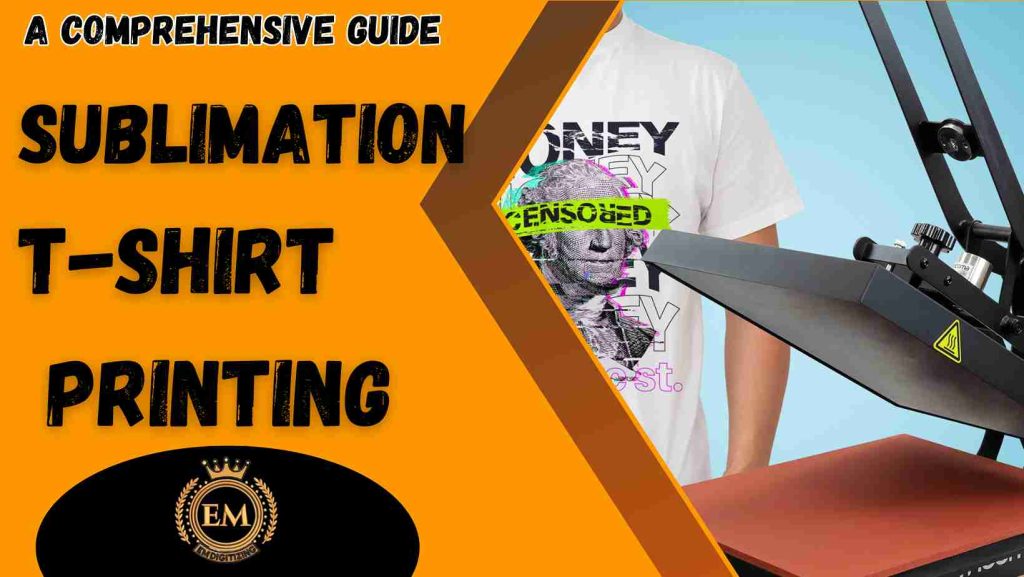
Impression de t-shirts par sublimation: Un guide complet
Qu'est-ce que l'impression par sublimation?
C'est un processus qui utilise la chaleur pour transférer la teinture dans des matériaux comme les tissus., céramique, ou des métaux. L'encre utilisée dans l'impression par sublimation se transforme en gaz lorsqu'elle est chauffée, lui permettant de pénétrer dans les fibres du matériau et de créer des couleurs vibrantes., impressions durables.
Cette méthode est particulièrement efficace sur les surfaces enduites de polyester ou de polymère, produire des images de haute qualité, durables et résistantes à la décoloration, fissuration, ou pelage. Contrairement aux méthodes d'impression traditionnelles, la sublimation intègre le design directement dans le matériau, résultant en une finition lisse qui fait partie du tissu ou de l'objet.
Avantages:
- Couleurs vibrantes: Produit lumineux, impressions de haute qualité aux couleurs riches.
- Durabilité: Les motifs sont intégrés dans le tissu, les rendant résistants à la décoloration, fissuration, ou pelage.
- Finition lisse: Pas de couches supplémentaires, donnant une continuité, sensation de douceur.
- Respectueux de l'environnement: Utilise moins d'eau et d'énergie par rapport aux autres méthodes d'impression.
Limites:
- Restrictions relatives aux tissus: Fonctionne mieux sur les tissus en polyester ou enduits de polyester; pas idéal pour le coton.
- Couleurs claires uniquement: Limité aux vêtements blancs ou de couleur claire pour une reproduction précise des couleurs.
- Investissement initial: Nécessite des imprimantes spécifiques, encres, et matériaux, entraînant des coûts de démarrage plus élevés.
Matériaux nécessaires pour l'impression de t-shirts par sublimation
Pour commencer impression de t-shirt sublimation, vous aurez besoin de matériel et d’équipements spécifiques conçus pour ce processus. Vous trouverez ci-dessous les éléments essentiels avec de brèves descriptions et recommandations.
Imprimante à sublimation: Une imprimante spécialisée qui utilise de l'encre sublimation pour produire des images haute résolution pour le transfert sur les vêtements. Nous recommandons Epson SureColor ou Sawgrass pour des résultats de haute qualité.
Encre sublimation: Cette encre se transforme en gaz lorsqu'il est chauffé, lui permettant de fusionner avec un tissu polyester, Assurer des impressions dynamiques et durables. Nous vous suggérons d'utiliser des encres d'herbe à scie authentique pour des impressions durables et vibrantes.
Papier sublimation: Un papier de transfert résistant à la chaleur qui maintient la conception imprimée et la libère sur le tissu lorsqu'il est pressé avec de la chaleur. Nous recommandons le papier A-Sub ou Texprint pour les transferts d'images de haute qualité.
Machine à chaleur: Une machine qui applique une chaleur et une pression élevées pour transférer l'encre de sublimation du papier sur le tissu. Nous recommandons des pressions de chaleur Fancierstudio ou PowerPress pour des performances cohérentes.
T-shirts en polyester ou en mélange de polyester élevé: La sublimation fonctionne mieux sur les vêtements en polyester ou sur les tissus à haute teneur en polyester pour un transfert de couleur optimal. Nous recommandons les t-shirts Jerzees ou Gildan avec au moins 65% teneur en polyester pour les meilleurs résultats.
Ruban résistant à la chaleur: Utilisé pour fixer le papier de sublimation sur le t-shirt pendant le processus de presse à chaud afin d'éviter tout déplacement. Nous recommandons le ruban adhésif Cricut résistant à la chaleur pour maintenir le papier en place en toute sécurité..
Papier protecteur ou feuille de téflon: Placé entre la presse à chaud et le papier de sublimation pour protéger à la fois le t-shirt et la presse à chaud des fuites d'encre. Nous recommandons des feuilles de téflon réutilisables pour une utilisation à long terme.
Logiciel de conception (Facultatif): Des programmes comme Adobe Illustrator ou CorelDRAW vous permettent de créer conceptions personnalisées et assurez-vous d'un dimensionnement approprié pour l'impression par sublimation. Nous recommandons Adobe Illustrator pour les professionnels et Canva pour les débutants pour la création de designs..
Processus étape par étape pour réaliser une impression de t-shirts par sublimation
Voici un guide complet sur la façon d’effectuer l’impression de t-shirts, décomposé en étapes claires:
1. Préparez votre conception

Commencez par créer ou sélectionner votre design à l'aide d'un logiciel de conception tel qu'Adobe Illustrator, CorelDRAW, ou Canva. Assurez-vous que le motif est de taille appropriée pour le t-shirt et qu'il a une haute résolution pour des résultats nets.. Si le design comprend du texte ou des images qui doivent être orientés d'une certaine manière, n'oubliez pas de refléter l'image avant l'impression pour qu'elle se transfère correctement sur le tissu.
Si votre image n'est pas claire ou en basse résolution, Ne vous inquiétez pas! ENumérisation peut le transformer en une image vectorielle de haute qualité pour vous. Nous offrons ce service à des prix abordables, en vous assurant que votre design sera net et prêt pour l'impression par sublimation.
2. Configurer l'imprimante à sublimation
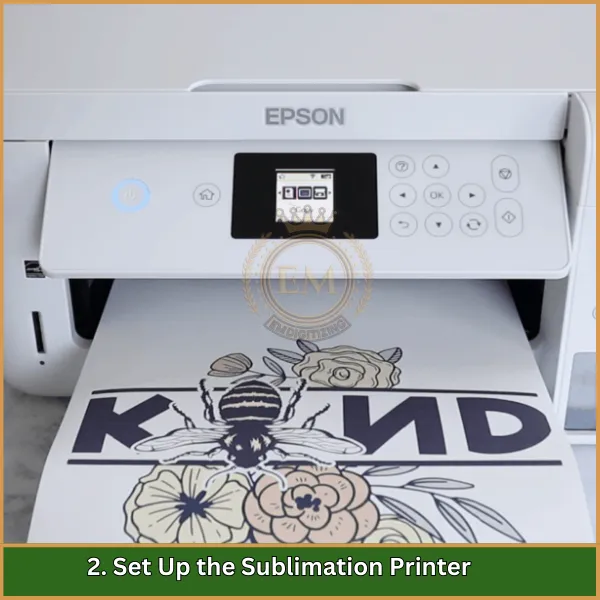
Chargez votre imprimante à sublimation avec de l'encre de sublimation et du papier de sublimation. Assurez-vous que tout est correctement aligné dans les paramètres de l'imprimante, et imprimez votre motif en miroir sur le papier de sublimation. Utiliser le bon papier et l'encre est essentiel pour des couleurs éclatantes et un transfert de haute qualité..
3. Préparez le tee-shirt
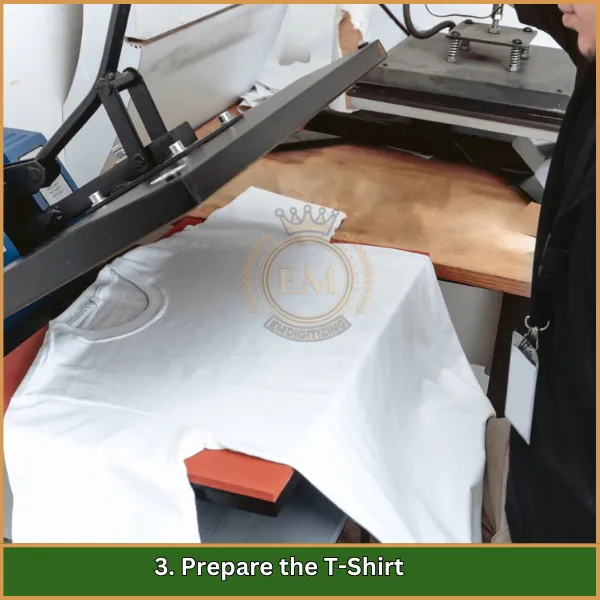
Sélectionnez un t-shirt en polyester ou en mélange de polyester, car la sublimation fonctionne mieux sur ces tissus. Au moins 65% le polyester est recommandé. Préchauffez votre presse à chaud à la température recommandée, généralement autour de 375-400°F, et pose ton t-shirt à plat sur la presse. Assurez-vous qu’il n’y a pas de rides, humidité, ou des peluches sur le tissu car celles-ci peuvent affecter la qualité du transfert.
4. Positionner le design sur le t-shirt

Une fois le t-shirt prêt, Placez votre design imprimé face vers le bas sur la zone où vous voulez qu'il transfère. Utilisez du ruban à chaleur pour fixer le papier sublimation au t-shirt, S'assurer qu'il ne bouge pas pendant le processus pressant. Un bon alignement est la clé pour obtenir votre design au bon endroit sur le t-shirt.
5. Appliquer la chaleur et la pression

Placer une feuille de téflon protectrice ou du papier parchemin sur le papier de sublimation et le t-shirt. Fermez la presse à chaleur, S'assurer que la pression correcte est appliquée. Appuyez sur le t-shirt pour 30-60 secondes, en fonction du tissu et appuyez sur les paramètres. Avoir à l'esprit d'utiliser la bonne température, temps, et pression pour éviter sous ou sur-transfert sur la conception.
6. Retirer le papier

Une fois le temps de pressage, ouvrez soigneusement la presse à chaud et décollez le papier de sublimation pendant qu'il est encore chaud. Le dessin doit maintenant être entièrement transféré sur le t-shirt, avec des couleurs vives et une finition lisse brodée dans le tissu.
7. Laissez le t-shirt refroidir
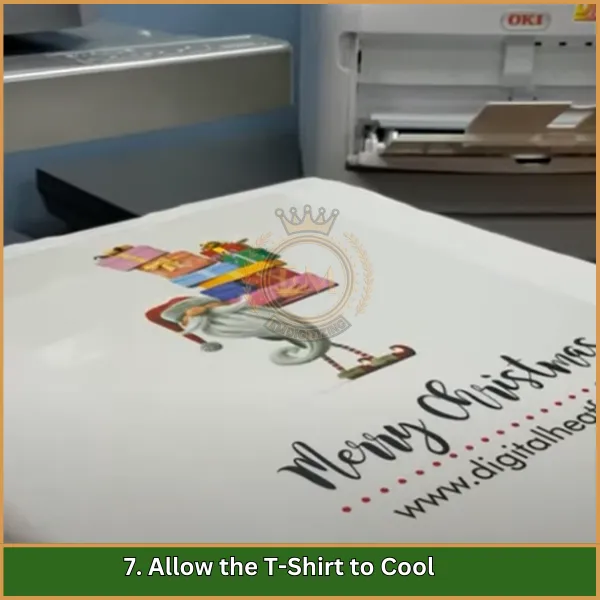
Laissez le t-shirt refroidir complètement avant de le manipuler pour éviter de tacher ou déformer l'impression. Le refroidissement permet aux encres de se déposer complètement dans le tissu, assurer une conception durable et durable.
8. Inspecter la conception
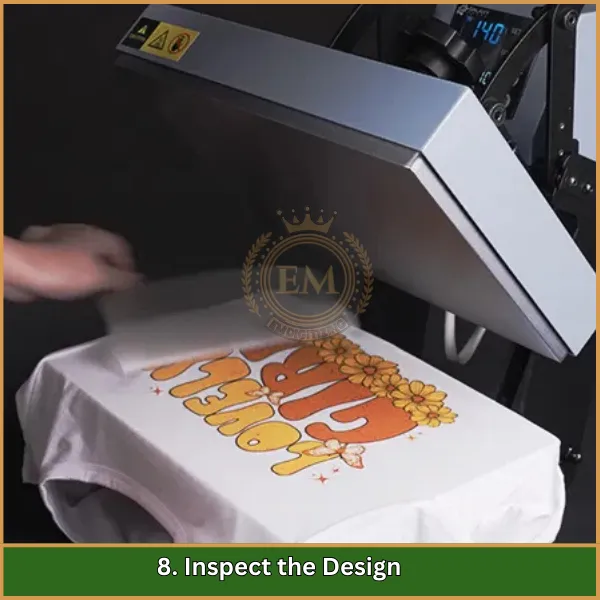
Une fois refroidi, examinez le t-shirt pour vous assurer que le motif a été transféré correctement. Vérifiez toute incohérence de couleur ou transfert incomplet. Si besoin, apporter des ajustements aux paramètres de votre presse à chaud pour les futures impressions afin d'améliorer la qualité.
Conseils pour obtenir des impressions par sublimation de haute qualité
Pour garantir que vos impressions de t-shirts par sublimation soient éclatantes, durable, et d'aspect professionnel, Considérez les conseils suivants:
- Utiliser des conceptions à haute résolution: Assurez-vous que votre conception a au moins 300 DPI pour les impressions claires et nettes.
- Choisissez le bon tissu: Utilisez des tissus de mélange en polyester ou à haut polyester pour un transfert de couleurs optimal.
- Préchauffer le t-shirt: Préchauffer le tissu pendant quelques secondes pour éliminer l'humidité et les rides avant d'appuyer.
- Définir la température et la pression correctes: Suivez les paramètres recommandés pour la température, pression, et le temps basé sur votre tissu et votre machine.
- Utiliser du ruban à la chaleur: Fixez le papier sublimation avec du ruban soumis à la chaleur pour éviter le déplacement pendant la presse.
- Protéger la presse à chaleur: Utilisez toujours une feuille de téflon ou du papier parchemin pour protéger la presse contre la fuite d'encre.
- Peler du papier à chaud: Retirez le papier sublimation alors qu'il est encore chaud pour un transfert plus propre.
- Vérifiez régulièrement les niveaux d'encre: Maintenir des niveaux d'encre appropriés pour éviter les impressions fanées et assurer des couleurs vibrantes.
En suivant ces conseils, Vous pouvez obtenir des impressions de sublimation de haute qualité qui se démarquent et durent.
Comment prendre soin des t-shirts imprimés par sublimation?
Des soins appropriés sont essentiels pour maintenir le dynamisme et la longévité des t-shirts imprimés par sublimation. Suivez ces conseils simples pour garder vos impressions fraîches:
- Laver à l'eau froide: Utilisez de l'eau froide pour éviter la décoloration et maintenir la luminosité de la conception.
- Tourner à l'envers: Tournez le t-shirt avant de se laver pour protéger l'impression de la friction.
- Utiliser un détergent doux: Évitez les produits chimiques durs ou le blanchissement qui peuvent endommager l'impression.
- Évitez les adoucisseurs en tissu: Les adoucisseurs de tissu peuvent affaiblir l'impression au fil du temps.
- À feu à l'air ou à feu doux: Le séchage à l'air est préféré, Mais si vous utilisez une sécheuse, Réglez-le à feu doux pour éviter d'endommager l'impression.
- Évitez de repasser l'impression: Si le repassage est nécessaire, Évitez la chaleur directe sur la conception imprimée; fer à reposer ou utiliser un chiffon de protection.
En suivant ces instructions de soins, Vous pouvez prolonger la durée de vie de vos t-shirts imprimés de sublimation et les garder plus longtemps.
Conclusion
L'impression de t-shirt sublimation de teinture est un moyen facile et efficace de créer, conceptions dynamiques. Whether you’;Réfacturez des t-shirts pour un usage personnel ou pour votre entreprise, Cette technique garantit que vos impressions auront fière allure et dureront longtemps. Avec les bonnes étapes, Tout le monde peut obtenir des résultats de qualité professionnelle.
Besoin conceptions vectorielles personnalisées pour vos projets? Emdigitising vous a couvert! Nous nous spécialisons dans la prestation de services de vectorisation de haute qualité avec un revirement rapide et des prix abordables. Et pour les nouveaux clients, Nous offrons un incroyable 50% rabais.
Laissez-nous vous aider à donner vie à vos idées de conception!
FAQ
La meilleure imprimante pour les t-shirts est souvent considérée comme la Sawgrass Virtuoso SG500, connu pour ses impressions de haute qualité, fiabilité, et compatibilité avec divers papiers transfert.
Pour utiliser une imprimante, d'abord, imprimez votre dessin sur du papier de sublimation à l'aide de l'imprimante, utilisez ensuite une presse à chaud pour transférer l'encre du papier vers une chemise à base de polyester sous haute température et pression.
L'impression par sublimation sur les t-shirts dure généralement toute la durée de vie de la chemise., car le colorant se lie chimiquement au tissu et résiste à la décoloration due au lavage ou au soleil.
